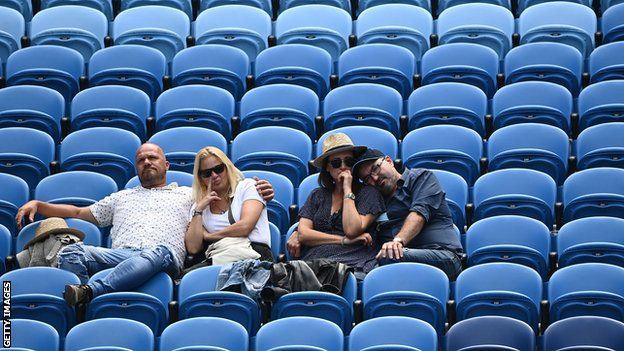Australian Open: Fans back as Grand Slam gets under way in Melbourne
- Published

Fans watch Austrian third seed Dominic Thiem - last year's men's singles runner-up - take on Kazakhstan's Mikhail Kukushkin on Rod Laver Arena
Throngs of excited fans walking along the Yarra River in the summer sun turns into a hubbub of noise and colour inside Melbourne Park on the opening day of the Australian Open. In normal times.
This year, however, players and fans alike are simply grateful there is even an Australian Open going on at all.
Taking place in a country that has enforced some of the world's toughest restrictions during the coronavirus pandemic, months of hard work and negotiations came to fruition when the first Grand Slam of the year started on Monday.
Tournament organisers revealed there were 17,922 visitors on an opening day when star attractions including Novak Djokovic and Serena Williams were in action. In comparison, 64,387 passed through the gates last year.
Nevertheless, it represents a triumph for Australian Open organisers. No tennis tournaments - nor many other events in the sporting world - have been allowed to host this number of people since the pandemic began.
Starting three weeks later than usual to enable players to quarantine, up to 30,000 fans are allowed on to the site each day.
The stands are not tightly packed like usual, though. People are sitting in socially distanced groups, mostly without masks, leaving large numbers of empty blue seats.
Fans are not craning necks and finding unusual vantage points to catch a glimpse of the action, they are instead following strict protocols and using some of the 800 hand sanitiser dispensers.
The outdoor concourses are not bubbling with the usual party atmosphere, either. Instead, it's click and collect for food and drink and QR codes for contact tracing.
Melbourne Park has been split into three zones to enforce social distancing, with a maximum of 10,000 spectators in each zone.
"There is so much space, no queues for the toilets or the bars. You can do all that and there are major seeds playing on the outer courts," said commentator Alison Mitchell, one of those at the venue.
"That has been the crazy thing about day one."
The overcast weather in Melbourne also may have contributed to few fans wandering around the site
Mitchell told Tennis Breakfast on BBC Radio 5 Live Sports Extra that crowds seemed to have increased for the evening session.
"There is a bit more bustle," she said. "But one of my friends - who had a day ticket for Margaret Court Arena - told me that he received a text saying if you have a day session ticket, you can enter the MCA night session free of charge.
"That tells you on day one they haven't sold out MCA for the night session, which also says all you need to know about Melburnians being nervous about coming in."
There has been a mixed reaction in Melbourne to the decision to go ahead with the Australian Open, with many locals worried about the Covid risks of so many players travelling to the area.
The tournament's delayed start means it is not taking place in the school summer holidays as usual. Mitchell says the fear of being contact traced - and subsequently having to do a 14-day quarantine - is also keeping people away.
"Melburnians are scarred. They've had it tough," she said.
Some of those fans who were there showed their Australian colours
While there might not be the buzz of previous years at the 'Happy Slam', the players are relieved to have any semblance of a crowd to play in front of after a US Open behind closed doors and a French Open limited to crowds of 1,000.
"I felt like there was more interaction than in New York because in New York it was just a generic crowd noise every point. This was more fun," 2019 champion Naomi Osaka said.
Asked about the vibe, Canada's Milos Raonic said: "If you're referring to the Australian Open last year, then it's quite different. If you're referring to the US Open, it's quite different as well.
"It was nice to see people rolling in and be able to come see tennis. I think people will get the confidence [to attend] once they sort of see the first few days go by."
One fan already undaunted was Boris Trbojevic, who travelled 1,700km from Brisbane to watch the tennis for a few days.
"It's a risk, but that's the way it is," the 30-year-old said. "Australia as a country has been doing great. Just one new case overnight, but it's one case out of 25 million people."